Financial econometrics - theory
1/581
There's no tags or description
Looks like no tags are added yet.
Name | Mastery | Learn | Test | Matching | Spaced |
|---|
No study sessions yet.
582 Terms
advantage of cash
liquidity
disadvantage of cash
subject to inflation/devaluation
advantage of having percentage of GDP when talking about volume of trade
global GDP is growing, it is better to standardized somehow
using the dollar is subject to inflation so this will result in skewed results

What do these numbers mean?
127.64 is the last price the share was slod at
0.58 is the different in the current trade and the previous close (it is lower)
the first trading price of the day was 127.82
we mainly use the closing price for empirical work
what does a smaller bid-ask spread result in?
high levels of liquidity
formula for 1-period simple return

formula for 1-period log return

formula for k-period simple return
the operator on the right hand side is the product operator

formula for k-period log return
we simply aggregate the log returns which we can’t do with simple returns as we have to compound it ourselves
simply the sum of the single period log returns over the period

formula for annualised simple return
useful when we have two returns measured in different frequencies
assume monthly returns will persist for 12 months

formula for annualised log return
useful when we have two returns measured in different frequencies
assume monthly returns will persist for 12 months

formula for portfolio simple return
simple is preferred to log as it is additive

formula for annualized log return


is a dollar return scale-free?
no
examples of price-weighted indices
dow jones industrial average index (dow jones/DJIA) (US)
Nikkei 225 index (Nikkei/NKX) (Tokyo)
examples of value-weighted indices
Deutscher Aktien Index (DAX) (Germany)
Financial Times Stock Exchange 100 Index (FTSE) (UK)
Hang Seng Index (Hang Seng/HSX) (Hong Kong)
Standard and Poors Composite 500 (S&P 500)
stylised facts about financial data
heavy tails (measured by kurtosis (4th movement))
asymmetry (measured by skewness (3rd movement))
we use t-distribution for financial data
volatility clustering
departure from normality
long-range dependence (2nd order dependence)
log price of an asset is typically an integrated process
some series of the log prices of assets keep co-movement in long run but some trending variables can have spurious (not genuine) relationships
details about heavy tails in financial data
the density of asset returns has heavier tails than normal
there is excessively high proportion of extreme values
distribution is still centred/symmetric but the probability of extreme values is higher than normal
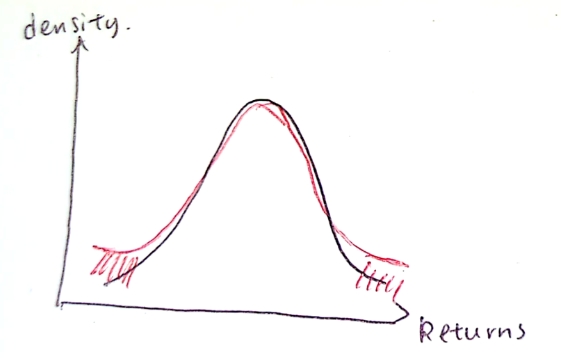
details about asymmetry in financial data
the density of asset returns is slightly negatively skewed
there is higher proportion of negative returns than positive returns
more likely to get a negative return than a positive return
earnings could be positively skewed (skewed to the right)
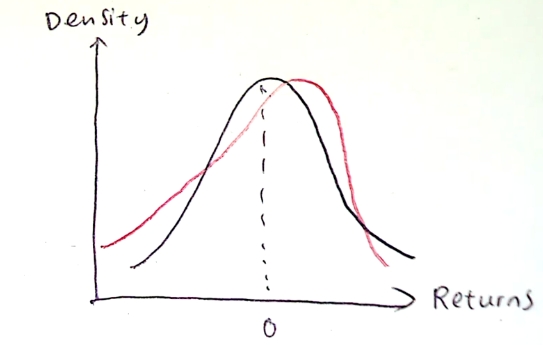
details about volatility clustering in financial data
large changes in log price comes in clusters
this issue has been extensively studied in ARCH (autoregressive conditional heteroskedasticity) literature
periods of high volatility tend to follow high volatility periods
periods of low volatility tend to follow each other
we observe period of low volatility, periods of high volatility, periods of low volatility, etc.
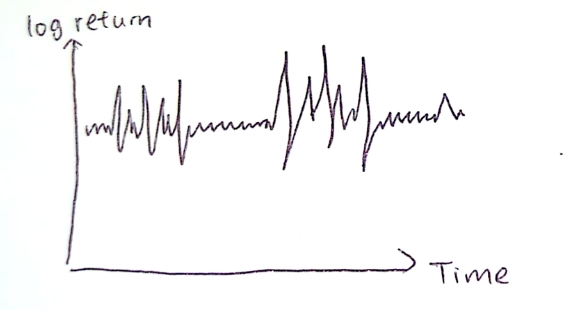
details about departure from normality in financial data
high frequency asset returns show obvious departure from normality
the distribution of asset returns at other frequencies also tends to be non-normal
details about long-range dependence in financial data
one observes strong serial correlation in variance (not mean) of returns
r²t or IrtI is strongly autocorrelated
this feature may help explain volatility clustering
details about log price of an asset being an integrated process in financial data
many such series appear to have upward trends
such series commonly have unit roots, which affect inference
mean and variance are not constant over time
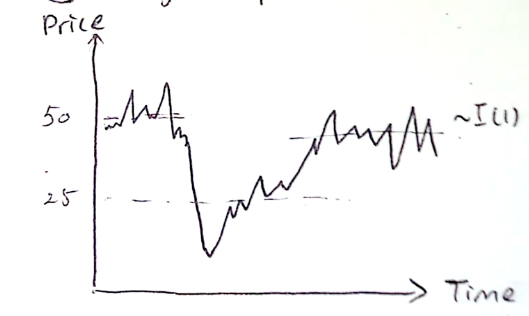
graphical representation of co-movement of prices and dividends
not moving at the same level but their movements are very similar
if they are both I(1) processes, we could model them together to make a stationary process
could model how they would move in the long-run

if prices are exponential, what do we expect log prices to be?
linear, growing at a constant rate
if log prices are linear, we expect log returns to be constant
Pt - Pt-1 = some constant
do we expect returns to follow a leptokurtic or platykurtic distribution?
leptokurtic
formula for mean
1st moment - where is the distribution centred?

formula for variance
2nd moment - how spread out is the distribution?

formula for skewness
3rd moment - is the distribution symmetric?
SK < 0 = negatively skewed, SK >0 = positively skewed

formula for kurtosis
4th moment - the tail behaviour of the distribution
we compare this to the value KT = 3 as this is the kurtosis value of a normal distribution

formula for excess kurtosis
distribution with positive excess kurtosis is leptokurtic
distribution with negative excess kurtosis is platykurtic

formula for volatility
also the formula for sample standard deviation which is the square root of the sample variance
variance will be non-zero and positive (as it is squared)

formula for sample covariance
we use this when we have two time-series

formula for sample correlation
value will range between -1 and 1
if the correlation = 0, the assets are linearly independent

when there are large outliers, is the median or the mean preferred?
the median
if we used the mean, the outlier would skew the mean calculation
which percentiles of distribution are important in finance?
the 1st and 5th percentiles to measure the value at risk
why do we need to calculate VaR?
the financial system can become less stable when huge losses are suffered by financial institutions in the system
we measure the potential loss faced by banks to reflect financial sector stability
example of value-at-risk
the 1% value at risk for the next h periods conditional on information at time T is the 1st percentile of expected trading revenue (which can be a gain or a loss) at the end of the next h periods
if the daily 1% value at risk is $30 million, there is a 1% chance the bank will lose $30 million or more after 1 day
although $30 million is a loss, by convention, the value at risk is quoted as a positive number
historical simulation for computing VaR
the historical method simply computes the percentiles of the empirical distribution from historical data
the variance method for computing VaR
the method assumes that returns are normally distributed
we use 2.33 as it is a one-sided test (calculating the loss so just looking at the left tail of the distribution)
where ɥ and σ are the sample mean and standard of the returns (respectively)

monte carlo simulation for computing value-at-risk
involves simulating a model for returns several times and constructing simulated percentiles
using a model to make forecasts of future values of the asset or portfolio and then assessing the uncertainty in the forecast
what does 1% VaR mean?
you would hope 1% falls below your prediction
if below 1% falls below your prediction, you are very conservative
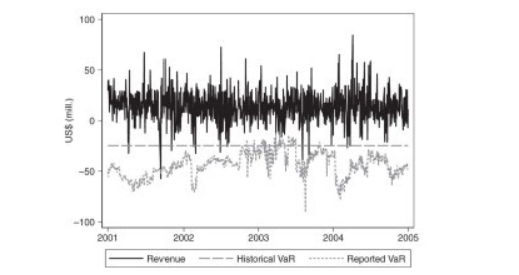
autocorrelation formula
it is similar to the correlation formula
only applied to one variable and its own lag, instead of two variables
the numerator represents the autocovariance of returns k periods apart
the denominator represents the variance of returns

if EMH is true, what does it imply?
the current price of an asset reflects all relevant information available on the market
the current price provides no information regarding future asset movements
future returns are completely unpredictable, given information on past returns
traders cannot systematically use newly arriving information to make a profit
conditional on all previous information, returns are completely random
what does zero autocorrelation imply?
returns exhibit no predictability
EMH exists
future movements in returns are unpredictable in terms of their own past history
foreign exchange rate is considered to be efficient as the autocorrelation ~ 0
if returns exhibit positive/negative autocorrelation, what does this imply?
this pattern can be exploited to predict future behaviour
EMH is violated
variance ratio of 1-period
alternative way to examine the EMH
we are comparing the variance ratio on returns over different time horizons


variance of n-period returns
nr(~) = sample mean of the n-period returns rnt
alternative way to examine the EMH
we are comparing the variance ratio on returns over different time horizons

how do we construct the variance ratio?
we first impose that the variances rt, rt-1, rt-2,…, are the same and do not depend on t
we are imposing the assumption of homoskedasticity for this to work
if there is no autocorrelation, what does the variance of n-periods equal to?
the variance of n-period returns should equal n times the variance of the 1-period returns
the ratio is known as the variance ratio

significant values for the variance ratio
= 1 means no autocorrelation
>1 = positive autocorrelation
<1 = negative correlation
if we have VRn = 0.99, we would have to conduct a hypothesis test as we can’t assume there is no autocorrelation just because the value is close to 1
limitations of autocorrelation
not a universal measure of predictability
can capture, at most, linear predictability of mean returns
possible for us to extend the concept of autocorrelation to measure predictability of higher moments such as variance, skewness, or kurtosis
autocorrelation in squared returns formula

characteristics of autocorrelation in squared returns
we can have negligible acf(k) and sizeable acf²(k)
this is case, the mean is not predictable but the variance is
this does not violate the EMH as it is only concerned with the expected value of returns, and not their variance (or higher moments)
in fact, many functions of returns can display predictability, in terms of autocorrelations
why do we need to use financial econometrics?
hope to help regulators and policy markers to be better equipped to assist in monitoring markets toward the goal of financial stability
also to guide the smooth functioning of financial markets in the face of crisis
distinguishing feature is that there is an abundance of financial data
how can foreign exchange be seen as a cash investment?
the exchange rate is simply the price of one currency in terms of another
the use of summary estimates of prices
we are increasing the number of observations
does not always increase the efficiency or improve understanding
the effect of a dividend payment
to lower the share price by the amount of the dividend
the closing price of the previous day is greater than the opening price of the following day
process of adjustment does not mean that historical prices reflect the actual prices at which trades took place
adjustment for a 2-for-1 stock split
a company replaces each existing share by two shares
the price of the share is immediately halved
makes the shares look more affordable, even though the market capitalization of the company has not changed
to make the prices before and after the split comparable, all historical prices need to be divided by 2 and the historical volume series needs to be multiplied by 2
disadvantages of dollar returns
not scale-free
does not measure the return relative to the initial investment
depends on the unit in which prices and dividends are quoted
simple gross return formula
rearranged the simple return formula
useful to represent the value at time t of investing $1 at time t-1

are simple returns additive when computing multi-period returns?
no
due to the multiplicative effect of period-by-period returns
whereas log returns are continuously compounded returns
what is the significance of e=2.17828 for log returns?
represents the value of an account at the end of year that started with $1 and paid 100% interest per year but the interest compounded continuously over time
how many trading days are there?
approximately 252 (due to public holidays/leap year)
are continuously compounded returns similar to simple returns?
only if the return is small
generally the case for monthly and daily returns
simple and gross returns with dividend payments formulae
Dt/Pt-1 = dividend yield

log returns with dividend payments formula

log return on a portfolio
= Rpt when Rpt is small
Rpt = portfolio rate of return which is equal to the weighted average of the returns to the assets

formula for Dow Jones index
D = Dow Jones divisor
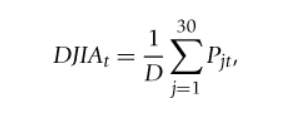
advantages and disadvantages of price weighting
+ simplicity
- stocks with the highest price have a greater relative impact on the index than they perhaps should
- the price-weighted index overemphasised market movements during the period of the dot com bubble, as well as the speed of the recovery form the 2008 global financial crisis
disadvantage of value weighting
securities whose prices have risen the most (or fallen the most) have a greater (or lower) weight in the index
price of zero-coupon bond
the right hand side is the discounted present value of the principal
-nynt= discount rate

yield on a zero-coupon bond
the yield is inversely proportional to the natural logarithm of the price of the bond
-1/n = constant

features of yield curves
at any point in time when the yield curve is observed, all the maturities may not be represented
this is particularly true at longer maturities where the number of observations yields is much sparser than at the short end of the maturity spectrum
the yields at longer maturities tend to be less volatile than the yields at the shorter end of the maturity spectrum
the shape of the yield curve is determined by the demand and supply of the bonds of various maturities, market expectations, and risk assessments
formula for exponential pattern in stock prices
Pt = current equity price
Pt-1 = previous month price
rt = rate of the increase between month t-1 and month t
the second equation shows if we restrict rt to take the same constant value
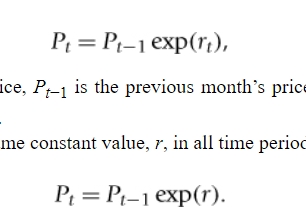
general formula for the relationship between the current price and the price t months earlier
rt = how many months between the two prices
the second equation is derived when we take the natural logarithms
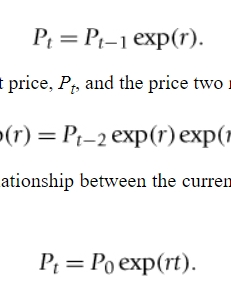
what is the effect of measuring returns over very short periods of time?
any tendency of prices to drift upward is virtually imperceptible as the effect is so small and is swamped by the apparent volatility of returns
returns generally focus on short-run effects whereas price movements can trend noticeably upward/downward over extended periods of time

the present value model formula
where dt = discount rate (on denominator)
the price of an equity is equal to the discounted future stream of dividend payments
results in deriving the yield curve (last line)
the relationship between equity prices and dividends is upward exponentially trending, with stronger intermittent downturns for equity prices
can change the property by combining two or more series
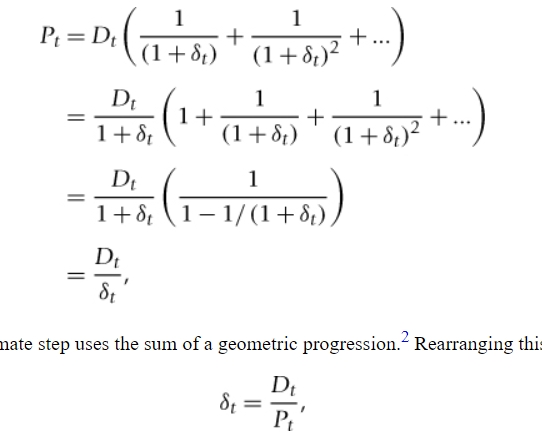
natural logarithms equation of the present value model
reveals the linear relationship between logPt and logDt

3 important properties of yields of zero-coupon bonds
yields are increasing over time, so they exhibit some form of trending behaviour
the variance of the yields tends to grow as the levels of the yields increase (levels effect)
yields of different maturities follow one another closely
important distinguishing feature of transactions data
the time interval between trades is not regularly/equally spaced
if high-frequency data are used, there will be period where no trades occur and the price won’t change
an example when the sample mean is an inappropriate summary measure
when the data are trending
how does positive/negative skewness change the shape of the distribution?
positive skewness = heavier right tail
negative skewness = heavier left tail
properties of correlation
has the same sign as the covariance
lies in the range -1</= cjj </= 1
not unit dependent as the measurement units are scaled out
VaR example
if the daily 1% h-period VaR is $30mil, there is a 1% chance that the bank will lose $30mil or more
difference of the VaR computed from the variance method and the historical method
the value computed from the variance method is slightly lower than that computed by historical returns as the assumption of normality ignores the slightly fatter tails exhibited by the empirical distribution of daily trading revenues
ways to use sample statistics to test the efficient market hypothesis
test asset returns for predictability
compare the variance of asset returns over different time horizons
autocorrelation of returns reveal information about the temporal dependence properties of the levels of returns
reveals information about the autocorrelation properties of the squared levels of returns
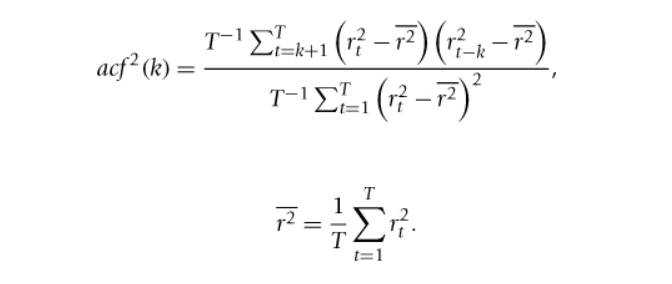
if the squared level of returns are predictable, does this violate EMH?
as long as the level of returns are not predictable, this does not violate EMH
EMH is only concerned with the expected value of the level of returns
various power transformations of returns computed by autocorrelation
first one = skewness
second one = kurtosis
third one = the absolute magnitude of returns (alternative measure of the presence of autocorrelation of variance)
last one = general power transformation
if a = 0.5, this is the autocorrelation of the standard deviation

what does the presence of stronger autocorrelation in squared returns than returns themselves suggest?
it suggests that other transformations of returns may reveal even stronger autocorrelation patterns
proof that a variance ratio of 1 means no autocorrelation
we are using an n=3 period return
sum of the three 1-period returns in the first equation
r(-) = sample mean for the 1-period return
we square both sides and average over a sample size T which gives what we see in the picture
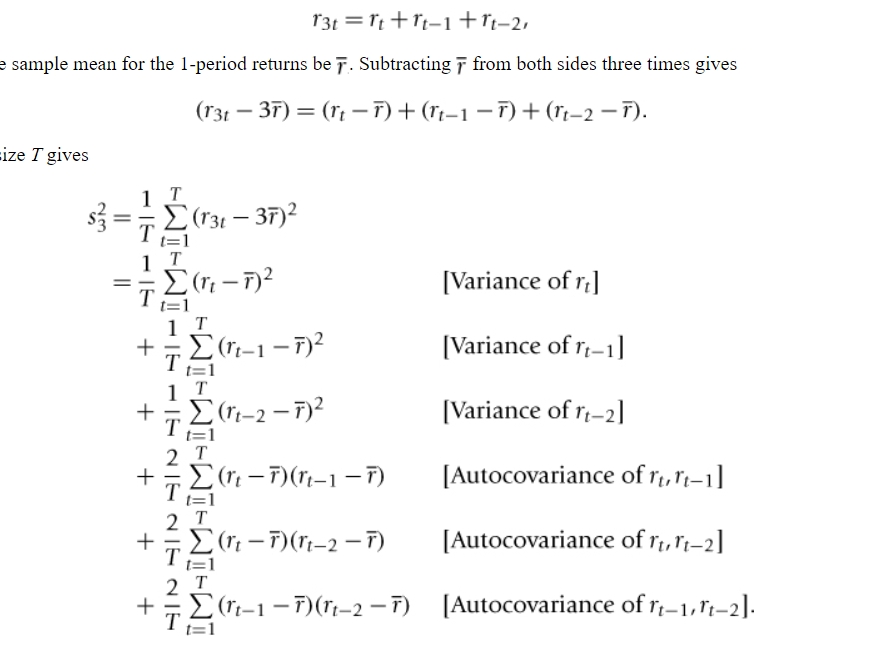
in the case of zero sample autocovariances, what does the variance ratio relationship simplify to?
the second equation shows if we assume the sample variance for rt is the same as the sample variance for rt-1 and rt-2
there is no sample autocorrelation in the n=3 period return
this falls under the covariance stationarity assumption

does regression always capture causal relationships?
no
for example, we could find an increase in ice cream sales and an increase in crime rates (spurious relationship)
predictive regression, ie yt = monthly indicators
being in december doesn’t explain migration but having the december indicator can help us to predict net migration in that month
CAPM formula (in terms of beta risk)
describes the risk characteristics of an asset in terms of B-risk
rit - rft = the return on asset i relative to the risk-free rate rft (excess return)
rmt - rft = market return relative to the risk-free rate
we can use the treasury bill rate as rft and S&P 500 returns as rmt
the numerator is the covariance between the excess returns on the asset and the market and the denominator is the variance of the market
the expression is the same as the slope estimate for simple linear regression where cov(y,x)/var(x)

what is the support of beta in the CAPM?
it is on the real line
covariance is unbounded
variance is non-negative and unbounded
the relative magnitudes of the covariance and variance are unclear to us so beta could take any value from -∞ to ∞
how are individual stocks or portfolio stocks classified?
in terms of their degree of B-risk
moving in the same direction as market = aggressive, benchmark, conservative
moving in the opposite direction as the market = imperfect hedge, perfect hedge
when beta is positive, it follows the same direction as the market (benchmark)
when beta is negative, it moves in the opposite direction as the market (hedge)
B= 0 when there is no covariance so the numerator is zero (the assets are independent)
ie if rit = rft
the denominator cannot be zero as this means it is constant
the covariance between a variable and some constant is always zero
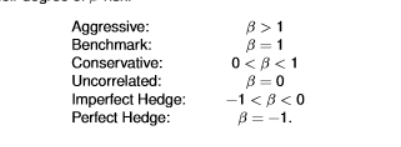
with which type of beta risk do we earn the market return?
benchmark
beta = 1
with which beta-risk do we earn the risk-free return?
uncorrelated
B = 0
this means that it is independent of the market
how do we estimate beta?
we use the linear regression model
the disturbance term ut captures additional movements in the dependent variable not predicted by CAPM
if we did not include this, we would assume the regression is perfect; no unobservables at all
we assume zero conditional mean, that is E[ut Irmt - rft] = 0 (we have removed the market factor already)
we prefer a positive alpha (we want to earn that little bit extra compared to the market
two unknowns:
the intercept parameter a captures the average abnormal returns to the asset given the relative risks
the slope parameters B corresponds to the asset’s beta-risk
rit - rft = the excess return on asset (dependent variable)
a = captures the abnormal return to the asset over and above the asset’s exposure to the excess return on the market
if a>0, the asset earns higher (abnormal) returns in excess of the return predicted by CAPM
if a<0, the asset earns lower (abnormal) returns in excess of the return predicted by CAPM
b = beta risk
rmt - rft = excess return on market (explanatory variable)
ut = captures additional movements in the dependent variable not captured by CAPM
![<ul><li><p>we use the linear regression model</p></li><li><p>the disturbance term ut captures additional movements in the dependent variable not predicted by CAPM</p></li><li><p>if we did not include this, we would assume the regression is perfect; no unobservables at all</p></li><li><p>we assume zero conditional mean, that is E[ut Irmt - rft] = 0 (we have removed the market factor already)</p></li><li><p>we prefer a positive alpha (we want to earn that little bit extra compared to the market</p></li><li><p>two unknowns:</p></li><li><p>the intercept parameter a captures the average abnormal returns to the asset given the relative risks</p></li><li><p>the slope parameters B corresponds to the asset’s beta-risk</p></li><li><p>rit - rft = the excess return on asset (dependent variable)</p></li><li><p>a = captures the abnormal return to the asset over and above the asset’s exposure to the excess return on the market</p></li><li><p>if a>0, the asset earns higher (abnormal) returns in excess of the return predicted by CAPM </p></li><li><p>if a<0, the asset earns lower (abnormal) returns in excess of the return predicted by CAPM</p></li><li><p>b = beta risk</p></li><li><p>rmt - rft = excess return on market (explanatory variable)</p></li><li><p>ut = captures additional movements in the dependent variable not captured by CAPM</p></li></ul><p></p>](https://knowt-user-attachments.s3.amazonaws.com/8d275808-323a-44d3-86ac-f951ea0332dc.jpg)